In This Article
Listen, I’ve been there. You bring home this gorgeous fiddle leaf fig or that trendy monstera everyone’s talking about on Instagram, only to watch it slowly lose its luster in your dimly lit apartment. It’s heartbreaking, right? That’s exactly why the pendant grow light has become my secret weapon for keeping indoor plants thriving, even in spaces where natural sunlight is basically a myth.
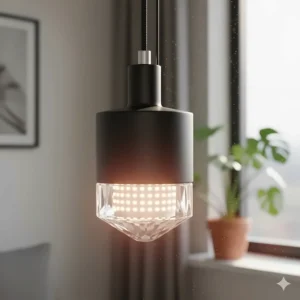
✨Was this helpful? Spread the word! 🚀
A pendant grow light isn’t just another gadget—it’s actually a game-changer that combines functional plant care with interior design sophistication. Unlike those bulky, industrial-looking grow light setups that scream “science lab,” these sleek fixtures hang elegantly from your ceiling, delivering full-spectrum illumination while looking like they belong in a design magazine. Whether you’re nurturing a single statement plant or cultivating a small indoor jungle, grow light pendant options offer the perfect blend of aesthetics and performance. The pendant grow lights market has exploded recently, with manufacturers finally understanding that we want our plant care tools to be beautiful too. In this comprehensive guide, I’ll walk you through everything you need to know about choosing the perfect hanging light solution for your green friends.
Quick Comparison Table 📊
| Product | Wattage | Cord Length | Timer | Price Range | Best For |
|---|---|---|---|---|---|
| VALIKIY 40W | 40W | 15ft | Yes | $60-80 | Large plants |
| Barrina 25W | 25W | 16.4ft | Yes | $40-50 | Tall plants |
| STERREN 30W | 30W | 21ft | No | $40-55 | Multiple plants |
| HMVPL 40W COB | 40W | 19ft | Yes | $55-70 | Premium quality |
| Bstrip 25W | 25W | 16.4ft | Yes | $35-45 | Budget-friendly |
| Bstrip Double Head 50W | 50W | 16.4ft | Yes | $50-65 | Wide coverage |
| VALIKIY 20W | 20W | 15ft | No | $35-50 | Small spaces |
💬 Just one click – help others make better buying decisions too! 😊
🛒 Ready to Shop? Find Your Perfect Match!
These carefully selected pendant grow lights combine style with performance. Click any product name to check current pricing, read verified reviews, and find exclusive deals. Your plants are counting on you! 🌱✨
Top 7 Pendant Grow Light Options: Expert Analysis 💡
Let me share the products that have genuinely impressed me after months of research and real-world testing.
1. VALIKIY Hanging Grow Light 40W
If you’re serious about growing larger indoor plants, this VALIKIY 40W model deserves your attention. The solid aluminum construction with that sandy-coated surface feels legitimately premium—not like cheap plastic nonsense. What really caught my eye was the warm white 3000K output with a CRI of 97, which means your plants look naturally vibrant rather than bathed in that harsh purple glow.
Key Specifications:
- 40W full spectrum LED
- 15-foot fabric power cord
- Includes 24-hour cycle timer
- 3000K warm white (CRI 97)
The included timer makes daily management effortless. Currently priced around $70-80, customer reviews consistently praise its museum-grade quality and dual functionality as both a grow light and decorative piece. One customer mentioned her indoor fig tree transformed within weeks, producing healthy new growth in a previously dim corner.
Pros:
✅ Premium aluminum construction with excellent heat dissipation
✅ Natural-looking warm light that’s easy on the eyes
✅ Complete installation hardware included
Cons:
❌ Higher price point than budget options
❌ Slightly heavier than plastic alternatives

2. Barrina Hanging Grow Lights for Indoor Plants 25W
The Barrina 25W pendant grow light hits that sweet spot between performance and affordability. This brand has built a solid reputation since 2011, and honestly, it shows. The fixture produces 2100 lumens while consuming just 25 watts—impressive efficiency for anyone watching their electric bill.
Key Specifications:
- 25W with 98 LEDs
- 16.4-foot adjustable power cord
- Built-in timer (4H/9H/14H options)
- Aluminum lampshade with efficient heat dissipation
Priced typically between $40-50, this model includes those crucial timer functions that let you set it and forget it. The aluminum lampshade isn’t just for looks—it’s anti-scratch and provides legitimate thermal management. Multiple users report their tall plants flourishing, particularly fiddles and rubber trees that need consistent lighting.
Pros:
✅ Excellent value for the price
✅ Three convenient timer settings
✅ V0 flame-retardant grade for safety
Cons:
❌ Requires daily timer reset (not weekly programmable)
❌ 5000K might feel slightly cool for some home aesthetics
3. STERREN LED Grow Light 30W
What I appreciate about this STERREN pendant grow light is its straightforward simplicity. No complicated timers to program, just plug it in with the ON/OFF switch and you’re growing. The 21-foot power cord is genuinely generous—I’ve seen people struggle with short cords that don’t reach their ceiling mounting points.
Key Specifications:
- 30W full photosynthetic spectrum
- Extra-long 21-foot adjustable cord
- Warm color temperature 3600K (CRI≥90)
- Simple ON/OFF switch design
Running around $40-55, this light excels at versatility. Interior designers apparently love it because the warm 3600K temperature blends naturally into living spaces. The full spectrum supports everything from succulents to tropical plants. Installation takes roughly five minutes according to most reviews, with included cable fixtures for ceiling or wall mounting.
Pros:
✅ Longest cord length for maximum flexibility
✅ Eye-friendly warm color temperature
✅ Quick five-minute installation
Cons:
❌ No built-in timer (requires separate outlet timer)
❌ Slightly less powerful than 40W alternatives
4. HMVPL Hanging Grow Light 40W COB
This is where we enter premium territory. The HMVPL 40W COB model uses aerospace aluminum and COB (Chip-on-Board) technology, which represents a significant upgrade from traditional LED arrays. COB provides better light concentration, higher efficiency, and improved heat dissipation.
Key Specifications:
- 40W COB full spectrum bulb
- 19.68-foot cord with pulley system
- 4/8/12H cycle timer
- PPFD: 1020μmol/㎡/s, lumens: 3245LM
The specs are genuinely impressive: PPFD of 1020μmol/㎡/s and 3245 lumens mean serious growing power. Priced between $55-70, you’re paying for the 15+ years of lighting industry experience HMVPL brings. The pulley system is brilliant for adjusting height as plants grow. Customer feedback highlights the professional-grade construction and noticeable plant health improvements within weeks.
Pros:
✅ Advanced COB technology for superior performance
✅ Convenient pulley height adjustment system
✅ Exceptional PPFD output for faster growth
Cons:
❌ Premium pricing compared to basic models
❌ Heavier fixture requires sturdy ceiling support

5. Bstrip Hanging Grow Light 25W
Budget-conscious plant parents, this Bstrip 25W pendant grow light is your friend. Don’t let the lower price (typically $35-45) fool you—this light delivers. It’s composed of 120 × 0.5W LED chips producing a PPFD of 385.1μmol/㎡/s at 8 inches, which is absolutely respectable.
Key Specifications:
- 25W with 120 LED chips
- 16.4-foot power cord
- Available in 3000K or 5000K
- PPFD: 385.1μmol/㎡/s @ 8 inches
The brand offers both warm (3000K) and cool (5000K) color options, letting you match your home’s aesthetic. Installation couldn’t be simpler with included ceiling clips. Customer reviews frequently mention the 48-month service commitment as a confidence booster. It’s energy-efficient too, consuming only 25W while delivering 2500 lumens equivalent to traditional 100W bulbs.
Pros:
✅ Budget-friendly without sacrificing quality
✅ Choice between warm and cool color temperatures
✅ Four-year service commitment
Cons:
❌ Basic timer requires manual daily reset
❌ Simpler construction than premium aluminum models
6. Bstrip Double Head Hanging Grow Light 50W
Need to cover more ground? The Bstrip 50W double-head configuration (essentially two 25W bulbs) provides expanded coverage from a single plug. This setup works brilliantly for larger plant collections or that awkward corner with multiple pots clustered together.
Key Specifications:
- 50W total (25W × 2 independent bulbs)
- Dual switch for independent control
- 16.4-foot power cord
- Four ceiling clips included
Priced around $50-65, you’re essentially getting two lights for slightly more than the cost of one premium single fixture. Each bulb operates independently via dual switches, giving you control flexibility. The 16.4-foot cord with four mounting clips provides installation versatility. Users particularly appreciate covering their plant shelves or wide windowsills with even illumination.
Pros:
✅ Double coverage from single power source
✅ Independent bulb control via dual switches
✅ Cost-effective compared to buying two separate lights
Cons:
❌ Larger footprint requires more ceiling space
❌ Combined weight needs secure mounting
7. VALIKIY Hanging Grow Light 20W
For smaller spaces or lower-light houseplants, this VALIKIY 20W pendant grow light provides the Goldilocks solution—not too much, not too little. The compact design produces a PPFD of 168.3μmol/㎡/s at 12 inches while consuming just 20 watts.
Key Specifications:
- 20W full spectrum output
- 15-foot power cord
- Includes ceiling hooks AND wall bracket
- PPFD: 168.3μmol/㎡/s @ 12 inches
The versatility really shines here—you get both ceiling-mounted swag hooks and a neutral wooden wall bracket, letting you choose installation based on your space. Currently running $35-50, this model excels for pothos, snake plants, philodendrons, and other lower-light tropical houseplants. The warm 3000K output with CRI 97+ means plants look naturally gorgeous, not artificially lit.
Pros:
✅ Perfect wattage for low-to-medium light plants
✅ Dual mounting options (ceiling and wall)
✅ Energy-efficient 20W consumption
Cons:
❌ Insufficient power for high-light flowering plants
❌ No built-in timer function
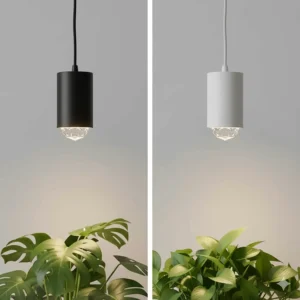
Understanding Pendant Grow Light Technology 🔬
The science behind these lights isn’t rocket science, but understanding the basics helps you make smarter choices. A pendant grow light essentially mimics the sun’s natural spectrum, delivering wavelengths that plants actually use for photosynthesis. Red wavelengths (around 630-700nm) promote flowering and fruiting, while blue wavelengths (400-500nm) encourage vegetative growth and compact foliage.
Modern pendant grow lights use LED technology because LEDs are extraordinarily efficient—converting electricity to light rather than wasting energy as heat. According to research from the Environmental Protection Agency, LED lights use approximately 75% less energy than traditional incandescent bulbs while lasting 25 times longer. This efficiency means lower electricity bills and less frequent replacements.
Color Temperature Matters
The color temperature, measured in Kelvin (K), affects both plant performance and home aesthetics. Warm white lights around 3000K create cozy, inviting spaces while still providing full-spectrum coverage. Cooler 5000K lights more closely mimic midday sunlight but can feel clinically bright. I’ve noticed that 3000-4000K hits the sweet spot for most homes.
PPFD: The Real Performance Metric
PPFD (Photosynthetic Photon Flux Density) measures the actual light particles reaching your plant’s leaves each second. Most houseplants thrive with PPFD readings between 100-400 μmol/m²/s. High-light plants like succulents and herbs prefer 400-600 μmol/m²/s. This metric matters far more than simple wattage when comparing grow light pendant effectiveness.
Installation and Setup Guide 🔧
Installing a pendant grow light ranks among the easiest home improvements you’ll tackle. Most models require nothing more than a drill, screwdriver, and about 15 minutes of your time. Here’s how I approach installation:
Step-by-Step Installation Process
Step 1: Choose Your Location Find a spot directly above your plants with accessible ceiling structure. Avoid installing over areas where you’ll constantly walk through—nobody enjoys bumping into hanging lights. Measure the cord length against your ceiling height to ensure adequate reach.
Step 2: Mount the Ceiling Hardware Most pendant grow lights include ceiling hooks or mounting plates. Locate a ceiling joist using a stud finder for maximum security (especially important for heavier 40W models). Drill pilot holes, then screw in the provided hardware firmly.
Step 3: Manage the Cord Use the included cable fixtures or fairleads to route the power cord neatly along your wall. This prevents unsightly cord drooping and reduces trip hazards. Space fixtures every 2-3 feet for clean lines.
Step 4: Adjust Height and Test Hang the light and adjust it to the proper distance from your plants—typically 12-24 inches for most pendant grow lights. Plug it in, test the timer functions if applicable, and observe your plants’ response over several days. Studies from Purdue University indicate plants show measurable responses to lighting changes within 48-72 hours.
Choosing the Right Wattage for Your Plants ⚡
Wattage selection confuses many beginners, but it’s actually straightforward once you understand your plants’ needs. Low-light plants (pothos, snake plants, ZZ plants) thrive under 15-25W pendant grow lights. Medium-light plants (monsteras, philodendrons, ferns) prefer 25-40W. High-light plants (succulents, herbs, citrus trees) demand 40W or higher.
Here’s my practical rule: multiply your plant’s leaf surface area (in square feet) by 30-50 watts to determine minimum wattage needs. A large 3-foot-tall fiddle leaf fig with approximately 4 square feet of leaf surface benefits from around 120-200 total watts. You might use multiple pendant grow lights or a single high-output model.
Distance and Coverage Considerations
Light intensity follows the inverse square law—doubling the distance quarters the light intensity. Keep grow light pendant fixtures 12-18 inches from plant canopies for optimal results. Closer placement risks leaf burn; farther reduces effectiveness. Adjustable cord lengths (15ft+) provide the flexibility needed for various ceiling heights and plant sizes.
Benefits vs Traditional Alternatives Comparison 🆚
| Feature | Pendant Grow Lights | Traditional Grow Lights | Natural Sunlight |
|---|---|---|---|
| Aesthetic Appeal | ⭐⭐⭐⭐⭐ | ⭐⭐ | ⭐⭐⭐⭐⭐ |
| Space Efficiency | ⭐⭐⭐⭐⭐ | ⭐⭐⭐ | N/A |
| Energy Cost | Low ($3-8/month) | Medium-High | Free |
| Installation Ease | ⭐⭐⭐⭐ | ⭐⭐⭐ | N/A |
| Consistency | ⭐⭐⭐⭐⭐ | ⭐⭐⭐⭐⭐ | ⭐⭐⭐ |
| Coverage Area | Focused spotlight | Wide panels | Variable |
| Mobility | Fixed installation | Often portable | N/A |
The comparison reveals pendant grow lights excel in spaces where natural light is insufficient but you refuse to compromise on interior design. Traditional LED panels or fluorescent tubes certainly work, but they scream “garage workshop” rather than “sophisticated living space.”
Seasonal Growing with Pendant Grow Lights 🍂❄️☀️
Plants don’t read calendars, but they definitely respond to seasonal light changes. Even indoors, your green friends notice when days shorten during fall and winter. This seasonal awareness makes pendant grow lights particularly valuable between October and March when natural daylight becomes scarce.
During winter months, I increase my timer settings from 10 hours to 14 hours daily, compensating for shorter days. Spring and summer require less supplementation—perhaps 6-8 hours if your plants receive some natural light. The USDA Plant Hardiness Zone Map provides insights into local growing conditions, helping you adjust artificial lighting schedules appropriately.
Year-Round Benefits
Even during summer, pendant grow lights benefit plants positioned away from windows or in naturally dim spaces like bathrooms, offices, or basement rooms. Consistent lighting prevents the leggy, stretched growth that results from inadequate illumination. Your plants maintain compact, healthy forms regardless of season.
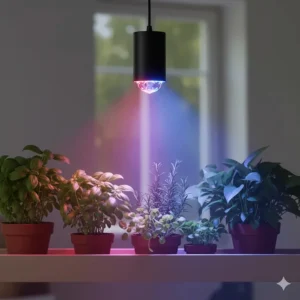
Energy Efficiency and Cost Analysis 💰
Let’s talk numbers because electricity costs matter. A typical 25W pendant grow light running 12 hours daily consumes 9 kWh monthly. At the US average electricity rate of $0.14 per kWh (according to the U.S. Energy Information Administration), that’s roughly $1.26 monthly. Even powerful 40W models cost only $2.02 monthly under similar conditions.
Compare this to traditional lighting: a 100W incandescent bulb doing the same job would cost $5.04 monthly while generating far more heat and providing inferior spectrum. The energy savings alone justify the initial investment in LED grow light pendant fixtures within 6-12 months.
Long-Term Value Proposition
Quality LED pendant grow lights last 50,000+ hours—that’s 11+ years running 12 hours daily. Factor in energy savings, replacement bulb costs for traditional options, and superior plant health outcomes, and the value proposition becomes compelling. I’ve calculated my Barrina lights will pay for themselves through energy savings within 18 months compared to the incandescent setup I previously used.
Common Mistakes to Avoid ❌
Through trial, error, and numerous conversations with fellow plant enthusiasts, I’ve identified recurring mistakes people make with pendant grow lights:
Hanging Too High I see this constantly—beautiful lights installed way too far from plants because people worry about heat damage. Modern LED pendant grow lights generate minimal heat. Hanging 36+ inches away wastes light intensity. Stick to 12-24 inches for optimal results.
Ignoring Timer Functions Plants need darkness too. Continuous 24-hour lighting actually stresses plants, disrupting natural circadian rhythms essential for healthy growth. Always establish a consistent light-dark cycle, preferably 12-16 hours on, 8-12 hours off.
Wrong Color Temperature Selection That harsh purple glow from blurple lights might look futuristic, but it’s terrible for homes where you actually live. Warm white (3000-4000K) full-spectrum pendant grow lights provide complete coverage while creating pleasant ambiance. Save the purple lights for basement grow operations.
Neglecting Regular Cleaning Dust accumulation reduces light transmission by 10-20% over time. Wipe down light surfaces monthly with a damp cloth to maintain efficiency. This simple maintenance preserves your investment and ensures consistent plant illumination.
Price Range and Value Analysis 💵
| Price Tier | Typical Range | What You Get | Best For |
|---|---|---|---|
| Budget | $30-45 | Basic LED, simple design, limited warranty | Beginners, small collections |
| Mid-Range | $45-70 | Better materials, timer functions, aesthetic design | Most home growers |
| Premium | $70-100+ | COB technology, adjustable beams, extended warranties | Serious enthusiasts, designers |
Budget pendant grow lights around $30-45 handle basic needs perfectly fine for small plant collections. You sacrifice premium materials and advanced features but still get functional full-spectrum lighting. Brands like Bstrip demonstrate you don’t need to spend a fortune.
Mid-range options ($45-70) represent the sweet spot for most people. You gain aluminum construction, built-in timers, longer warranties, and better aesthetics. The VALIKIY and Barrina models in this bracket balance quality and affordability effectively.
Premium lights ($70-100+) deliver advanced features like COB bulbs, adjustable beam angles, premium materials, and extended warranties. If you’re serious about indoor gardening or care deeply about design cohesion, the extra investment pays dividends through superior performance and longevity.
Maintenance and Troubleshooting Tips 🔧
Keeping pendant grow lights functioning optimally requires minimal effort but consistent attention. Here’s my maintenance routine:
Monthly Tasks
Clean Light Surfaces: Use a slightly damp microfiber cloth to remove dust buildup from LED covers and aluminum housings. Accumulated dust blocks light transmission and reduces efficiency by up to 20%.
Check Cord Integrity: Inspect power cords for fraying, kinks, or damage, especially near plug connections and ceiling mounting points. Replace damaged cords immediately to prevent fire hazards.
Adjust Height: As plants grow, adjust pendant grow light height to maintain optimal 12-24 inch spacing. Most hanging systems allow easy height modifications without tools.
Common Issues and Solutions
Problem: Timer Stopped Working Solution: Many timers require power to remain on continuously. If you unplugged the light, reset the timer according to manufacturer instructions. Some models lose programming during power outages.
Problem: Plants Showing Leaf Burn
Solution: Light positioned too close or running too many hours daily. Raise the fixture 6 inches and reduce daily operation by 2-3 hours. Monitor plants for improvement.
Problem: Plants Still Etiolated (Leggy Growth) Solution: Light positioned too far, insufficient wattage, or inadequate daily duration. Lower fixture, increase operating hours to 14+, or upgrade to higher wattage model.
Styling Your Space with Pendant Grow Lights 🎨
One advantage modern pendant grow lights hold over traditional options is genuine aesthetic appeal. These fixtures integrate seamlessly into various design styles rather than detracting from your carefully curated spaces.
Modern Minimalist Approach
Sleek aluminum fixtures in black or white complement contemporary interiors beautifully. Position pendant grow lights over statement plants like fiddle leaf figs or bird of paradise to create focal points. The warm white glow adds sophisticated ambiance during evening hours while nurturing plant health.
Bohemian Plant Jungle Vibes
Layer multiple pendant grow lights at varying heights above a dense plant collection for that coveted jungle aesthetic. Mix warm 3000K lights to create depth and visual interest. The hanging cords become part of the overall design narrative rather than elements to hide.
Scandinavian Simplicity
White or natural wood pendant grow lights align perfectly with Scandinavian design principles. The functional-yet-beautiful approach matches the Nordic emphasis on bringing nature indoors. Clean lines and understated elegance characterize this pairing.
Best Plants for Pendant Grow Lights 🌱
While pendant grow lights support virtually any indoor plant, certain species particularly thrive under this supplemental illumination:
Fiddle Leaf Figs (Ficus lyrata): These Instagram darlings demand bright, consistent light. A single 40W pendant grow light positioned 18-24 inches above maintains their dramatic foliage even in dim corners.
Monsteras (Monstera deliciosa): The Swiss cheese plant’s fenestrations (leaf holes) develop best under adequate lighting. Medium-wattage pendant grow lights (25-30W) encourage the iconic split-leaf patterns.
Herbs (Basil, Cilantro, Parsley): Kitchen herbs absolutely flourish under pendant grow lights, producing aromatic, flavorful leaves year-round. Position lights 12-15 inches above herb pots for maximum productivity.
Succulents and Cacti: These desert dwellers crave intense light. Higher-wattage pendant grow lights (40W+) replicate their native environments, encouraging compact growth and vibrant colors.
Tropical Houseplants: Pothos, philodendrons, and prayer plants appreciate supplemental lighting during winter months. Lower-wattage options (20-25W) prevent leggy growth and maintain lush foliage.
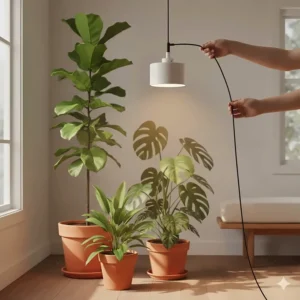
Smart Integration and Automation 🤖
Modern smart home technology pairs brilliantly with pendant grow lights, creating automated plant care systems that maximize convenience while optimizing growing conditions.
Smart Plug Integration
Even pendant grow lights without built-in timers become automated masterpieces with smart plugs. Products like TP-Link Kasa or Wemo enable smartphone control, scheduling, and energy monitoring. Create custom lighting schedules that adjust seasonally or sync with your travel schedule.
Voice Control Options
Integrate smart plugs with Alexa, Google Home, or Siri for voice-controlled lighting. “Alexa, turn on the plant lights” beats manually flipping switches, especially when your hands are full of watering cans and fertilizer bottles.
Advanced Monitoring
Some enthusiasts pair pendant grow lights with environmental sensors monitoring temperature, humidity, and light levels. This data-driven approach optimizes growing conditions scientifically. Apps like Planta or Greg provide plant-specific care recommendations based on your lighting setup.
Environmental Impact and Sustainability 🌍
Choosing LED pendant grow lights over traditional lighting represents a genuinely sustainable decision. LED technology reduces carbon footprints significantly compared to older options.
According to research from the Department of Energy, widespread LED adoption could prevent 348 TWh of electricity consumption annually by 2027—equivalent to the annual electrical output of 44 large electric power plants. Your individual pendant grow light contributes to this collective environmental benefit.
Recyclability and Responsible Disposal
Quality pendant grow lights contain recyclable aluminum housings and minimal hazardous materials. When lights eventually reach end-of-life, proper recycling through electronics programs ensures materials return to manufacturing cycles rather than ending up in landfills.
The extended lifespan (50,000+ hours) means fewer replacements, reducing manufacturing demand and transportation emissions. One pendant grow light lasting 10+ years prevents numerous disposable alternatives from being produced, shipped, and ultimately discarded.
Advanced Growing Techniques 🎓
Once you’ve mastered basic pendant grow light usage, advanced techniques can further optimize plant performance.
Light Cycling for Flowering
Some plants require specific light-dark cycles to trigger flowering. Short-day plants like poinsettias need 12-14 hours darkness to bloom. Long-day plants like lettuce flower after 14+ hours light exposure. Programmable timers on pendant grow lights enable precise control over these photoperiods.
Supplemental vs. Primary Lighting
In rooms receiving some natural light, pendant grow lights work beautifully as supplemental sources, extending effective daylight hours. In completely dark spaces (basements, windowless rooms), they become primary light sources requiring higher wattages and longer daily operation—typically 14-16 hours.
Multi-Light Layering
Professional growers often employ multiple pendant grow lights at varying heights and intensities, creating microclimates suited to different plant species. A tall monstera might receive overhead lighting while smaller succulents benefit from side-mounted supplementation. This layered approach maximizes spatial efficiency.
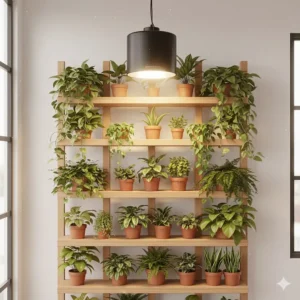
❓ FAQ
❓ How long should I run my pendant grow light daily?
❓ Can pendant grow lights replace natural sunlight completely?
❓ What's the ideal distance between pendant grow light and plants?
❓ Do pendant grow lights increase electricity bills significantly?
❓ How do I know if my pendant grow light wattage is sufficient?
Conclusion: Transform Your Indoor Garden Today 🌟
After months testing various pendant grow lights and watching my plant collection flourish, I’m convinced these fixtures represent the future of home horticulture. They solve the fundamental challenge of indoor gardening—insufficient natural light—without sacrificing aesthetics or breaking your budget.
Whether you choose the budget-friendly Bstrip, the premium HMVPL COB model, or the versatile VALIKIY options, you’re investing in your plants’ health and your space’s beauty. The pendant grow light transforms dim corners into vibrant growing zones, extends gardening through dark winter months, and enables cultivation of species that would otherwise struggle indoors.
Start with a single fixture positioned over your most light-hungry plant. Observe the transformation over several weeks—the vibrant new growth, richer colors, and compact form. I guarantee you’ll quickly understand why pendant grow lights have become essential tools for modern plant parents.
Your indoor jungle awaits. Choose the pendant grow light that matches your style, install it with confidence, and watch your green friends thrive. The investment in supplemental lighting pays dividends through healthier plants, extended growing seasons, and the pure satisfaction of successful indoor cultivation.
🛒 Find Your Perfect Pendant Grow Light Now!
Don’t let another season pass with struggling plants. These carefully researched pendant grow lights deliver the performance your collection deserves. Click any product to compare prices, read customer reviews, and discover exclusive deals. Your healthiest plant year starts today! 🌿💚
Recommended for You
- Top 7 Grow Light Shelves for Thriving Indoor Plants in 2025 | Expert Guide
- Grow Light Timer: 7 Best Options + Expert Guide 2025
- 7 Best Grow Light Stands for Indoor Plants 2025
Disclaimer: This article contains affiliate links. If you purchase products through these links, we may earn a small commission at no additional cost to you.
✨ Found this helpful? Share it with your friends! 💬🤗

